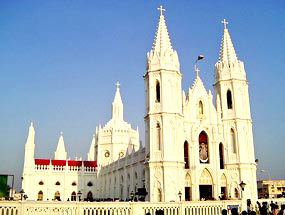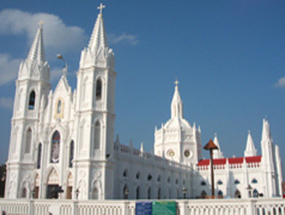Daily Services
Every Morning:
5:45 a.m. Holy Mass in Tamil
6:45 a.m. High Mass in Tamil
9:00 a.m. Holy Mass in Malayalam
10:00 a.m. Holy Mass in English
12:00 a.m. Holy Mass in Tamil
Every Evening :
6:00 p.m. Novena Prayers, Rosary, Evening prayers.
6:30 p.m. Holy Mass in Tamil.
Weekly Services
Thursday Evenings :
6:30 p.m. Holy Mass in Tamil
All Saturdays:
7:00 a.m. Holy Mass at Our Lady's Tank
5:45 p.m. Car Procession around the Shrine Basilica, Rosary, Novena prayers, Blessing with the Statue of Our Lady.
6:30 p.m. Holy Mass in Tamil
Sunday Morning :
5:45 a.m. Holy Mass in Tamil
7:30 a.m. High Mass in Tamil
10:00 a.m. Holy Mass in English
12:00 a.m. Holy Mass in Tamil
Sunday Evening :
5:30 p.m. Rosary, Novena Prayers
5:00 p.m. Holy Mass in Tamil
Monthly Services
First Friday :
6:00p.m. Eucharistic Procession around the Shrine.
First Saturday :
6:15 p.m. Blessing of the Sick with the Blessed Sacrament
Feast Celebration
(From 29th August to 8th September on every year)
6:00 p.m. Flag Procession, Blessing hoisting of the flag,Litany Benediction
7:00 p.m. Mass in Tamil
Liturgical Timings during Ten Novena Days in The Main Shrine.
5:00 a.m. Holy Mass, Blessing of the sick, Blessing with the statue of Our Lady of Health
8:00 p.m. Car Procession
In The Lower Extension Basilica
6:00 a.m. High Mass in Tamil
7:00 a.m. Holy Mass in Tamil
8:00 a.m. High Mass in English
10:00 a.m. Holy Mass in Tamil
11:00 a.m. Holy Mass in Konkani
12:00 noon Flag hoisting Mass in Tamil
4:15 p.m. Holy Mass in Marathi
6:30 p.m. Rosary, Novena Prayers, Litany, Sermon in Tamil and Benediction.
In The Upper Extension Basilica
6:00 a.m. Holy Mass in English
7:00 a.m. Holy Mass in Hindi
9:00 a.m. Holy Mass in Malayalam
4:00 p.m. Holy Mass in Telugu
5:00 p.m. Holy Mass in Tamil.
At Our Lady's Tank
6:00 a.m. Holy Mass in Tamil
5:00 p.m. Way of the Cross in the Holy Path (only on Friday)
At The Shrine Auditorium (on Feast Eve)
5:45 p.m. Rosary, Novena Prayers, Litany,followed by Pontifical High Mass presided over by His Excellency The Bishop of Thanjavur.
At The Main Shrine (on Feast Day)
6:15 a.m. Feast High Mass by His Excellency The Bishop of Thanjavur
6:00 p.m. Dismounting of our Lady's Flag.
Vailankanni is fondly known as the 'Lourdes of the East' because like Lourdes in France, millions of pilgrims visit the Shrine throughout the year, praying to Our Lady for various needs and thanking her for the favors received through her intercession. Tradition recounts that Mother Mary appeared with the Infant Jesus in this small hamlet at the end of the 16th or in the early 17th century. Ever since, Vailankanni is the most important destination and almost the synthesis of all Marian Sanctuaries for the pilgrims of the world. The crowds of pilgrims come here regardless of creeds and languages. Our Lady of Vailankanni devotions down through the centuries have proved the Shrine to be of divine origin and has assumed international character. Mary, the focus of unity at Vailankanni, is a clear proof of international, multicultural, and religious harmony.


As days passed on, the number of devout pilgrims visiting the Shrine increased. The fame of Vailankanni spread gradually. The wonderful but inexplicable events that occurred in the Shrine excited awe and wonder. People who witnessed the eventsor heard first-hand information about them, and related them to their family and friends. Thus the fame and glory of the gracious Mother of Health of Vailankanni spread like wildfire throughout the land. Year by year the number of devout pilgrims increased. Many came with eager and earnest prayers for favors, and immediate help; many more came with hearts filled with gratitude to show thanks to the miraculous Mother for favors granted.Very soon, even this extension was found to be inadequate. In 1917 Fr. Sebastio Xavier de Noronha expanded the Church by an another 20 ft. from the nave of the Church.In addition, two gothic domes of 82 ft. each on either side of the entrance facing the sea were also constructed. About the same time a two-story Parochial building with facility for pilgrims was also built.
His period was marked by rivalry between the Franciscans and the Jesuits and it had its influence on the missionaries in Vailankanni as well.
From the beginning of this century, there was an another church in Vailankanni dedicated to the Immaculate Heart of Mary, which was under the jurisdiction of the diocese of Trichy. It was maintained by the Jesuits. In 1928 a solution was found to this problem. The church of Immaculate Heart of Mary was demolished and the statues were brought to the Shrine of Our Lady of Health. By then, both the private and the public sectors began operating bus services to Our Lady's Shrine from all corners of the land. Hence the number of pilgrims pouring into Vailankanni further increased. In 1933 two new wings were constructed, to the right and to the left of the 'Main Altar', meeting the nave at right angles


Vailankanni, a hamlet on the sandy shores of the Bay of Bengal, is located 350 kilometers south of Chennai (Madras) and 12kilometers south of Nagappatinam. Nagapattinam, a town on the coast of Bay of Bengal, was referred by early writers and the Portuguese as "the city of Coramandel' (Imperial Gazetteer of India, XIX, 3). Vellayar river, a minor branch of the river Cauvery, runs on the south of the village and flows into the sea. Readers may be startled to learn that Vailankanni was once a port and there is evidence to prove this. Historical notes reveal that people in this area traded with Rome and Greece, the ancient commercial centers of the western world.In the course of time, Nagapattinam expanded and this tiny commercial center (Vailankanni) gradually lost its importance. The canal that had been dug once for navigation between Nagapattinam and Vedaranyam still lies to the west of Vailankanni.
To have constantcontact with the devotees, who may not be able to visit the Shrine often, in 1953, the Bishop started two monthly magazines, one in English (Vailankanni Calling) and another in Tamil (Vailankanni Kuraloli).. The celebration of the Marian Year all over the world in 1954 drew unprecedented numbers of pilgrims to the Shrine. The Most Reverend Bishop R. Arokiasamy Sundaram, the first bishop of Thanjavur, and Fr. M. V. Rodriguez, the parish priest made elaborate arrangements to celebrate the Marian Year meaningfully and propagate the Marian devotion at Vailankanni.In 1956, a beautiful welcome arch was blessed and opened by His Excellency Most Reverend Bishop Sundaram


The marble altar adds exquisite splendor to the Shrine. The ancient porcelain plates and paintings have been carefully retained in their original beauty.Enlarging the church for active participation in the Liturgy for the influx of various language-speaking pilgrims became imperative. This warranted a two-storied extended Basilica. So in 1974-75 during the time of late Very Rev. Fr. Maria Soosai the two story church was blessed and consecrated by Rt. Rev. R.A. Sundaram, then Bishop of Thanjavur.After all these renovations and the extensions, the present Church shows the triumph of classicism in structure, this magnificent edifice with its 93 ft. high dome and two 82 ft. high gothic spirals dominates the skyline of Vailankanni.
A spacious vestry was also provided immediately behind the Altar. Thus the entire sacred edifice began to assume the shape of a Latin Cross. Right over the center of the ancient main altar was the miraculous image of Our Lady of Health, (the verybeauty of the whole magnificent edifice, which remained untouched and unaltered).. With this the Shrine of 'Our Lady' was blessed in 1933, on the feast day of Our Lady of Immaculate Conception. The moral pillar behind all these developments was the parish priest, the Very Rev. Fr. Sebastio Xavier Noronha, who attained eternal grace on August 21, 1942. He was laid to rest in front of Our Lady's Shrine. In 1953, Thanjavur was separated from the Archdiocese of Madras-Mylapore and created as a separate diocese. Vailankanni came under the jurisdiction of Thanjavur Diocese.


In 1771 Fr. Antonio de Rozario, the last Parish Priest of the church of the Immaculate Conception, was appointed as the first Parish Priest of Vailankanni, which was then raised to the status of an independent parish. Till then, the parish of Vailankanni was a substation of the parish of Nagapattinam, and Nagapattinam had always been under the ecclesiastical jurisdiction of the Bishop of the Diocese of Mylapore. During that period the Diocese of Mylapore was administered under the Portuguese 'Padroado' (patronage). Under the Padroado system, the king of Portugal in Europe met all the expenses incurred by the Diocese of Mylapore, which remained under the ecclesiastical jurisdiction of the Roman Pontiffs. Until 1847 the priests of St. Franciscan Missionaries who had looked after the province of Goa and Mylapore also looked after Nagapattinam and Vailankanni.
The Franciscan origin and ownership of the Shrine was also perpetuated, by giving the place of honor to two Franciscan saints, St. Anthony of Lisbon and St. Francis of Assisi,
on either side of the miraculous image of 'Our Lady', on the High Altar until 1961. Besides the last parish priest, Miguel Francisco Fernandez, who was of the Franciscan order, controlled the parish of Vailankanni till 1889. In the year 1949 this dual system came to an end: the Portuguese patronage of the Diocese of Mylapore was ended and placed under the direct control of the Roman Pontiff. The Diocese of Mylapore was in charge of the mission in this area until 1952. It was in that year that Thanjavur, a Cauvery-fed basin, became a new and independent Diocese called the "Diocese of Thanjavur." Thanjavur town was chosen to be the headquarters of the new Diocese. In November 1952, when the new Diocese of Thanjavur came into being, the Diocesan Priests of Thanjavur became the custodians of the Shrine Vailankanni. The administration of the new Diocese was temporarily placed under the apostolic administration of the Rt. Rev. Dr. Louis Mathias, S.D.B., who was then the Archbishop of the new Archdiocese of Madras-Mylapore On March 19, 1953, His Excellency the Rev. Dr. R. Arokiasamy Sundaram, DD., L. C. L., M. A., a priest of Mylapore Archdiocese was appointed as the first Bishop of the new Diocese of Thanjavur. He assumed charge of his Diocese on March 24, 1953.
Vailankanni being situated in the Thanjavur District came under the jurisdiction of the Diocese of Thanjavur. The Rev. Dr. R. Arokiasamy Sundaram showed keen interest in the development of Vailankanni Shrine and granted special spiritual privileges. 'Our Lady of Health Vailankanni' became the second patroness of our newly erected Diocese